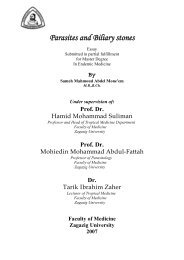Study of respiratory symptoms among sputum positive
Study of respiratory symptoms among sputum positive
Study of respiratory symptoms among sputum positive
You also want an ePaper? Increase the reach of your titles
YUMPU automatically turns print PDFs into web optimized ePapers that Google loves.
Tuberculous Mycobacteria<br />
The most common agent <strong>of</strong>pulmonary tuberculosis is the acid fast<br />
bacillus M.TB. It's a species <strong>of</strong> the genus mycobacterium, family<br />
mycobacteriacae, order actinomycetales (Jeraff, 1986). There are five<br />
closely related mycobacteria grouped in the M. tuberculosis complex: M.<br />
tuberculosis, M. bovis, M. africanum, M. microti and M. canetti<br />
(Vansoolingen et aI., 1997 and 1998).<br />
Morphology and growth requirements:<br />
Mycobacterial tuberculosis (M.TB) is a slender, straight or slightly<br />
curved rod, 0.5 I-l in length and 0.34 ).l in breadth. The bacilli are non<br />
motile, gram <strong>positive</strong>, aerobic, and do not form spores or capsules (ATS,<br />
1987). The growth requirements <strong>of</strong> mycobacteria on artificial media<br />
include potassium, magnesium, phosphorus, and sulfur. Ammonium salts<br />
or egg ingredients provide a nitrogen source, and glucose or glycerol<br />
supply a carbon source. The optional pH range for growth is 6.5 to 7.0.<br />
Although mycobacteria are strict aerobes, a CO2 concentration between 5 %<br />
and 10 % is necessary for their primary recovery on solid media. The<br />
incubation conditions should include high humidity and atemperature <strong>of</strong><br />
35 to 37°C (Zheng and Roberts, 1999).<br />
Cell wall structure:<br />
The cell envelope essentially distinguishes species <strong>of</strong> the<br />
. I mycobacterium genus from other prokarytes. Mycobacteria in general give<br />
.W<br />
a weakly <strong>positive</strong> response to the gram stain,are phylogenetically more<br />
closely related to gram <strong>positive</strong> bacteria (Draper, 1982), and lackthe<br />
4
















